Stretch Basics for Patternmaking 1: Introduction
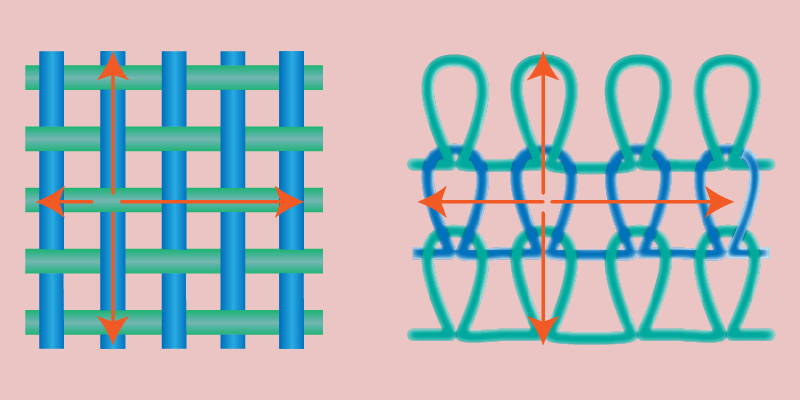
This is Part 1 of a series of 3 articles. This article covers the following:
- Difference between Woven and Knit Fabrics
- How fabric stretches
- How to tell the difference between Stretchwovens and Knits
- One-Way Stretch, Two-Way Stretch and Four-Way Stretch
- Amount of Stretch (or Stretch Ratio)
- How to determine the amount of stretch in a piece of fabric
- Considerations of Stretch (in Woven and Knits) for Patternmaking
Part 2 of this article goes into details about Stretch Blocks (the Torso Block is used as an example), and Part 3 covers difficulties that can be encountered when attempting to draft the Stretch Torso Block if you have a Non-Standard Figure that differs from the standard in particular ways, or in a number of ways. The theory covered will apply as well when drafting other blocks such as Skirt and Pants. These articles should also be read before drafting the Stretch Torso Block in the Blocks Menu.
The Difference Between Woven & Knit Fabrics
Let me start by saying that spandex or Lycra can be added to woven and knit garments to add stretch, but first we will look both of these fabrics in their natural state, and in the next section talk about adding spandex. If you understand the structure of the fabric, it is easier to understand why and how stretch and knit is often used interchangeably, although some woven fabric also has stretch.
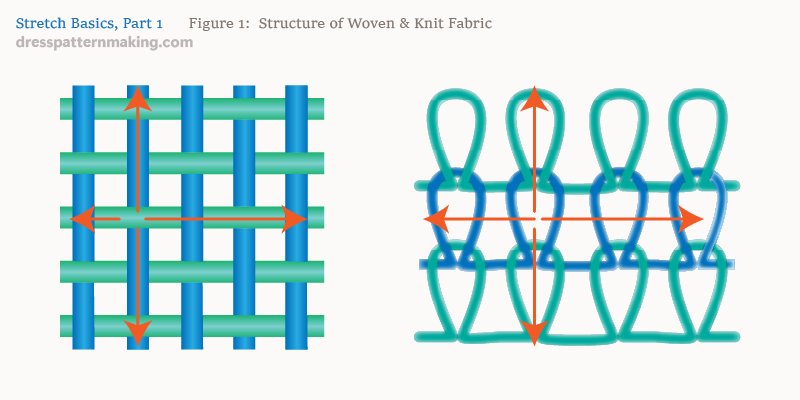
Woven Fabrics
Woven fabric is constructed by weaving (or interlacing) threads together on right angles to each other. Most thread in its natural form doesn't stretch. Looking at Image 1, imagine pulling at the woven fabric in the direction of the arrows. Either way, horizontally or vertically, you are pulling along the length of thread. Most thread in it's natural form doesn't stretch, so the fabric doesn't stretch. The knit fabric on the other hand is constructed of yarn that is looped by knitted stitches. Look at Image 2 and imagine pulling at this fabric in a horizontal direction:
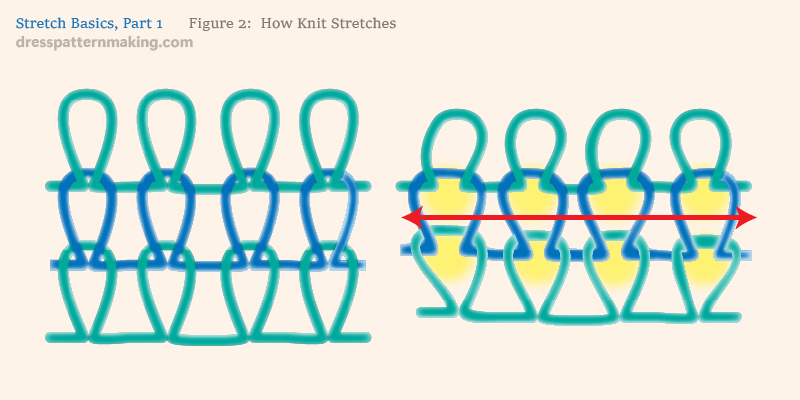
The yellow highlights show you where the loops are opening up, resulting in stretch. As you stretch horizontally, the loops flatten out a bit, and the length decreases a bit. Note that it is not the yarn itself that stretches, it is a result of the structure of the garment; i.e. how the loops of the knitted yarn respond to being pulled. As the yarn itself does not stretch, and the loops do not open in a vertical direction, when you pull in a vertically you will not get the same stretch as you do horizontally. You will get a little bit of 'give' as the horizontal rows of loops, (which in it's normal state relax together) get pulled taut, as in Figure 3 that follows:
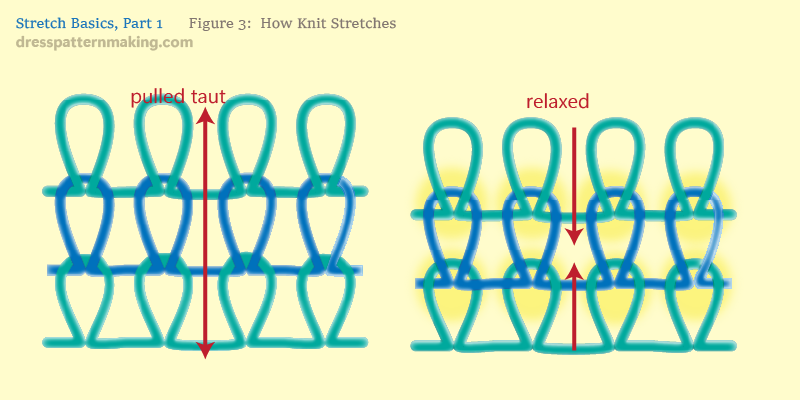
How to tell the difference between Stretchwovens & Knits
Sometimes fabrics such as jerseys are obviously knits, sometimes it's not so easy to tell, but the cut edge of the fabric will tell you whether it is a woven or a knit fabric. You can tell the tartan fabric below is a stretchwoven because the cut edge is frayed; the interlaced crosswise and lengthwise threads are coming apart, as can be seen in Figure 4 below:

In Figure 5, this velvet below has an edge that curls rather than frays; this shows it is a knit fabric. (Traditional velvet is a woven fabric made of silk and rayon; this velvet is made of polyester).

As in Figure 6, you can often tell the fabric is a knit just by looking at at the wrong side closely; you can see loops of fabric and the pattern of knit/purl stitch that you see in knitted scarves, etc.

Be aware that fabric that stretches on the lengthwise grain can curl on the selvedge, see Figure 7:

More Stretch: Adding Spandex/Lycra
Although the yarn itself does not stretch, spandex (or Lycra) can be added to the yarn to give it extra stretch. Likewise spandex/Lycra can be added to woven fabrics to give stretch. In both cases the spandex is added to the thread/yarn before the weaving/knitting process. The spandex is usually added to the crosswise direction in woven fabrics, but when added to the yarn used in knits it can be created so that more stretch is gained in one direction than another. For leotards and swimwear (garments that pass through the crotch) need more stretch in the lengthwise grain. What it is important to realize is that given that the structure of knits (loops of thread that can stretch when pulled) more stretch can be achieved with knitted fabrics than with woven fabrics. That is why Stretch and Knits are often used synonymously. You can always achieve more stretch with kitted yarn than with woven thread, and all of the super stretchy fabric is knitted fabric. The amount of stretch that can be gained with knits means that many garments can be made without darts and minimal seam-lines. Spandex is very useful in that it allows the fabric to go back to it's original size; it gives the garment Stretch Memory. With no spandex added, the garment will eventually stay stretched and be saggy in the direction of stretch, especially in key body parts that bend a lot like knees and elbows.
The Amount of Stretch, or Stretch Ratio
Fabrics with stretch are usually classified into the amount of stretch they contain and you would use a block that is drafted with that amount of stretch in mind. These are broad categories and so some level of discretion needs to be used when deciding how to draft patterns. (e.g. You have a block for fabric that stretches 18-25%, then another block for fabric that stretches 26-50%... Obviously you may not really be able to accurately determine whether a fabric stretches 25% or 26%.....). Each Stretch Ratio would, in the fashion industry, have it's own set of blocks/slopers. Of course in the fashion industry they would also have ways of determining the exact stretch ratio. These are the broad categories of stretch:
- Stretchwovens: Stretch about 18% (in the crosswise direction). ***
- Stable Knits: Knitted Fabrics that stretch between 18-25% (5 inches stretches to 6.25 inches).
- Moderate Knits: Knits that stretch between 26-50% (5 inches stretches to 7.25 inches)
- Stretchy Knits: Knits that stretch between 51-75% (5 inches stretches to 8 inches)
- Super-stretch Knits: Knits that stretch between 75-100% (5 inches stretches to 10 inches)
***Important Note: The prevailing wisdom is that Strecthwovens should be treated as woven; except you reduce the width of the block a little. Note that this is, in effect, creating a Stretch Block for Wovens. The reason they say that it shouldn't be classed as Stretch is that Stretch Blocks are dartless, and you would draft patterns for Stretchwovens with darts. But I'll discuss this later; although knit blocks are dartless, you often see knit garments with added fullness in the neckline or waist, which is in effect dart value left as fullness.
How to check the amount of stretch on a piece of fabric
Fold the fabric on the grain that you want to test - on the crosswise grain for Stretchwovens, crosswise and/or lengthwise for Knits. It is best not to check the stretch on the edge of the fabric. Fold it over so you are stretching a little distance away from the edge. Place two pins in the fabric, using a tape measure to mark a specific distance. In this case I am marking 4 inches (I am not starting at 0 because the metal edge is not an ideal starting spot). So I am placing pins at 1 and 5, which means I am testing 4 inches. I will see how much stretch I will get from 4 inches. Holding the fabric down on one side (in this case on 1 on the tape measure), stretch the fabric and check where the second pin ends up. In this case the second pin moved from 5 to 5.75. This means the fabric stretched 0.75-inch, which is a little less than 20% of the original 4 inches. Stretchwovens usually stretch up to a maximum of 18%. See Figure 8 (before stretching) and Figure 9 (after stretching) below.


One-Way, Two-Way and Four-Way Stretch
Fabrics can be categorized in three way, depending on what direction they stretch in and how/where the stretch is derived.
One Way Stretch
See Image 4 below. The stretchwoven on the left has spandex in the crosswise grain and stretches on the crossgrain only. The knit on the right has the standard knit loops and stretches on the cross-grain only. These both have one-way stretch.
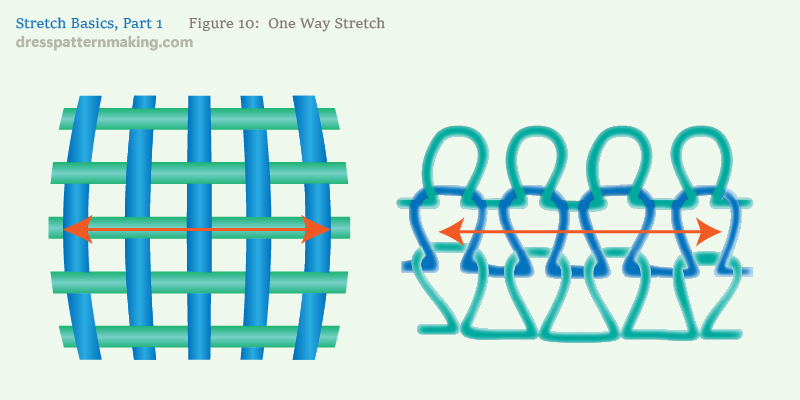
Two-Way Stretch
Remember how I said earlier that yarn only stretches (in it's natural form without spandex added) in the crosswise direction? Well, there is a method of making yarn stretch in the lengthwise direction also. This is done by texturixing and crimping the yarn so it ends up in a sort of spiral. See Image 5 below for an indication of how this works (excuse the poor graphic as it doesn't do justice to 'spirals', but I think you'll get the idea!). The stretch in two-way fabric is derived from the stitches and the yarn only, not by added spandex. Note that the fabric will over time tend will get 'fatigued' and won't bounce back as well. This two-way stretch doesn't have much fabric memory or elasticity. You wouldn't use two-way stretch to make garments like sportswear, leotards, swimsuits etc, as they would sag quite quickly.
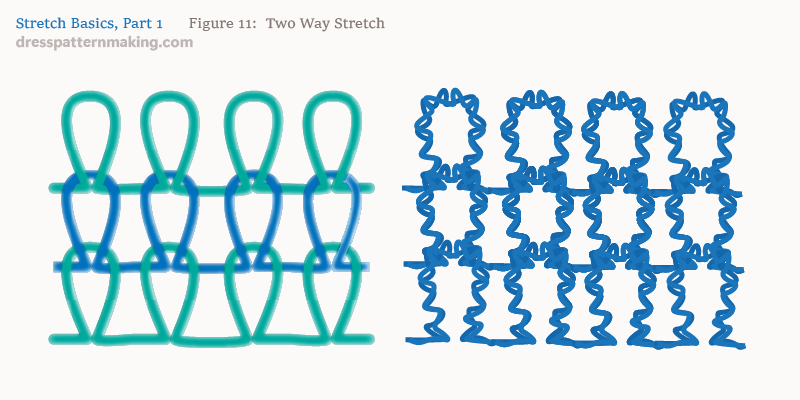
Four-Way Stretch
Four-way stretch fabric stretches in the crossgrain and the lengthwise grain. This fabric has spandex/Lycra added and has good fabric memory. It will return to it's original shape even after a lot of stretch over a long period of time. Some four-way fabrics stretches more on the cross-grain (T-shirts, dresses, etc) and some stretches more in the length-grain (leotards, bodysuits, etc). For fabric to be four-way stretch it must have spandex/Lycra added in the yarn. Think about four-way stretch as stretching out horizontally, then bouncing back in. Stretching down vertically, then bouncing back up. The elasticity of the fabric, the Stretch Memory, makes it four-way stretch.
Considerations when Drafting Patterns for Stretch and Knits
When drafting patterns for garments with stretch, you need to consider the following:
- Which direction the fabric stretches, and draft the pattern accordingly (e.g. for the most stretch to go around the body for a dress, but up and down for a leotard).
- Seam-lines such as the shoulder may need to be stabilized, keeping in mind that stabilized seams won't stretch, so you need to make sure you take that into account in the pattern. (e.g.If you stablize an opening where the head goes through, make sure there is enough room for the head).
- You need to use a block appropriate to the amount of stretch in the fabric, and the type of fabric (stretchwoven vs knits).
- You need to use the correct fabric for the garment at hand; you need to know when you can use two-way stretch and when you need four-way stretch.
- All knits have a nap, most have a shine; need to take this into account when drawing the grainline.
- If you've taken knit straight off a bolt, let it relax for 24 hours; sometimes it may be stretched a little when put on the bolt.

